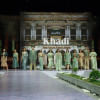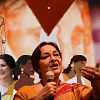The tapestry of Bangladesh's textile legacy is woven with generational artistry and cultural significance. As we weave together tradition and innovation, the nation stands poised to write a narrative of sustainable fashion that resonates across the world.
A closer look would shed some light.
Priceless treasures
Maheen Khan, a pioneer designer in the fashion industry of Bangladesh and Founder President of the Fashion Design Council of Bangladesh (FDCB), is someone whose work has always featured local artistry, adding her creativity to make outfits that speak tradition and exude elegance.
In conversation with us, she expressed, "We have so much to offer in terms of local textiles. Take cotton, khadi, or jamdani for instance. Each of these has earned its name from subtle differences in its making and the texture of the thread used. Does this not itself speak volumes of the intricacy of each fibre used?"
Faiza Ahmed, a designer and fashion activist, who started her work with local fabric agrees wholeheartedly.
"I realised that I cannot proudly claim 'Made in Bangladesh' by tracing designs on a piece of fabric that's not ours," she explained, adding, "When I decided to work with local textiles, my research revealed we, as a locality, are the epitome of sustainable fashion and creativity. And I wanted to be someone to showcase this."
One of the more recent additions to this rich legacy is the Kolaboti sari made out of banana plant fibre.

Shaing Shaing U Nini, Faculty and Coordinator of the School of Business Administration, Bandarban University, is one of the creative minds behind this entirely new fabric that holds the potential to add new dimension to Bangladesh's local textile.
"The initial plan was to make files or folders. However, as we began putting all elements together, it seemed to become a less feasible option. Be it the finances needed or the time, the returns from making folders out of banana fibre were not looking to be as rewarding. Then the idea struck to make this into the national outfit of Bangladesh, a sari," remarked Nini.
Bringing in the skills of artisan Radhavati Devi and support from the Bandarban District Commissioner, Nini and her team took on the challenge of making the first-ever Kolaboti sari that took 15 days to weave.
This diverse fibre, the first in Bangladesh and all its neighbouring countries, is eventually to be used for making bags, mats, purses or even shoes.
Talking of drawbacks and challenges, Nini stressed, "Extracting the yarn of banana fibre is rather difficult and costly. Then comes the time needed to weave a sari. If the returns do not match the time and efforts invested, it is highly discouraging."
The low returns are not isolated to Kolaboti saris only. As much as we would like to take pride in our natural fibres and artistry, the picture is no longer what it used to be.
The critical decline
Despite the rich legacy, the weavers' community is facing a decline. A shocking revelation by industry experts says that Benaroshi Polli, the biggest Benaroshi hub of Bangladesh, is currently struggling to keep up with incoming orders due to a lack of weavers.
Artisans have abandoned their art in large numbers because of economic difficulties they have faced over the years and the allure of more lucrative careers.
"The beauty of local fabrics like khadi, for instance, is in its hand-woven and hand-spun element of it. It is alarming and almost disheartening to see the drastic decline in the number of weavers in our country," expressed designer Maheen Khan.
Nini stresses that where once there used to be close to twenty thousand looms, the number has now fallen to less than a mere hundred due to a lack of skilled weavers.
Shedding some light on the practical aspect of it, Nini explains that with the cost of living on the rise, it is not fair of us to ask artisans to carry the burden of this legacy unless we can assure that the price they receive is equally rewarding.
"Because handloom weaving pays less than other popular occupations, the younger generation in particular is becoming less and less interested in pursuing it as a career. And they are not to blame. We are living in expensive times. Putting myself in their shoes, I also would not like to hold on to a tradition if it holds me back financially," she stated.
Tenzing Chakma, whose designs have added a new contemporary dimension to the traditional ethnic wear of Bangladesh, said, "Handmade products, be it dresses, shoes, scarves or accessories, are meant to be expensive."
"We are not only paying for the work we see, but also the effort and time spent behind bringing each piece together. While it is not uncommon or alarming for mass-produced outfits to be a part of our regular wear, we should not allow the authenticity of Bangladeshi natural textiles to be compromised in the process."
Chakma further explained how lack of guidance has made artisans very hesitant towards trying new designs and techniques, something that he had to overcome with his team over the years.
Faiza Ahmed added, "The challenge does not end with the declining number of weavers. It's also in the maintenance and quality assurance, which is especially tricky when it comes to several small-scale producers."
Time for revival
Today, there is a worldwide surge to go back to the roots; a call to go green, urging us all to embrace sustainability in all spheres of life, including fashion. And there is no better time to bring back the magic of hand-woven textiles than now.
Our local weaves come with a low carbon footprint; something that makes them extremely attractive in the global market. Not only are they as authentic and unique as can be, these natural weaves give us outfits that are more than mere clothes; they are a lifestyle choice.
Moreover, designers and industry experts unanimously agree that Bangladesh's textile heritage has significant potential in the global market.
Tenzing Chakma provided a simple example, stating, "One of my clients wanted a veil for her wedding. I had suggested Rajshahi Organza for it. It was smooth and flowy with the right texture to make it into a perfect veil. She was brave enough to take my suggestion and go outside the norms of chiffon or lace. And the results were stunning."
The unique textures, intricate designs, and rich cultural history of traditional fabrics like jamdani and muslin make them highly sought-after commodities among discerning fashion enthusiasts worldwide.
"Jamdani does not necessarily need to be a sari," explained Faiza Ahmed, adding, "In fact, if we can present it as a yard cloth, even with a price for its exclusivity, it will attract a huge crowd from all over the world."
By leveraging this cultural capital and embracing innovation, Bangladesh can position itself in the global market for sustainable and ethical fashion.
The way forward
While individual designers can train their teams or encourage a handful of people, they cannot initiate a bigger change unless guidance and support come from policymakers and government authorities.
Investing in training programmes for artisans is crucial to revitalising Bangladesh's textile heritage. By providing opportunities for skill development and entrepreneurship, artisans can expand their market reach and enhance the value of their craft.
Collaborations between government agencies, and non-profit organisations, as well as designers, can facilitate access to resources, markets, and technology, speeding up the process of retaining our cultural heritage.
Policies that prioritise the preservation and promotion of traditional crafts, along with initiatives to provide financial assistance and training to artisans, are essential to safeguarding Bangladesh's cultural legacy.
The way forward is anything but easy. However, it is not impossible. With traditional weaves and modern innovation, we are only a few steps away from making sustainable fashion that will create its own identity around the globe.
Photographer: Abrar Alvi Daanish
Model: Tabassum Borno
Designer: Zarin Rashid
Photo Courtesy: Kino








Comments